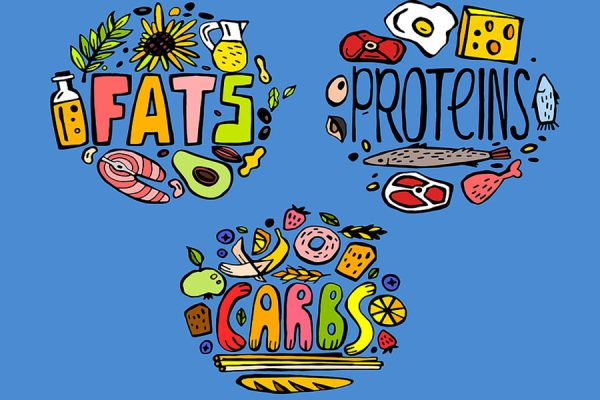Most people are making at least one of these macro mistakes, even experienced, educated dieters. The list could be a lot longer, but in this post below, I name the 6 biggest mistakes.

But first, a quick refresher:
Macros are short for “Macronutrients.”
There are three of them:
1. Protein
2. Carbohydrate (“carbs”)
3. Fat
[Sidebar: Yes, I know alcohol is technically a macro and has 7 calories per gram (second most calorie dense), but I hope you’re not doing a lot of boozy macro tracking.]
Macros and calories are synonymous in the sense that each macro has a certain number of calories per gram. So if someone says they are “tracking macros,” by definition they’re tracking calories too.
Protein: 4 calories per gram
Carbs: 4 calories per gram
Fats: 9 calories per gram (most calorie dense macro)
These numbers are known as the “Atwater factors” (because some dude with the last name Atwater discovered them over a century ago).
Little known fact: These are rounded numbers. A specific protein food might have 4.27 calories per gram. A particular type of carb might have 3.75 calories per gram.
You could get all the way to six pack abs without ever tracking macros. How? By simply tracking portion sizes, and adjusting them based on your weekly body composition results.
That said, tracking macros is the most fool-proof way to ensure you get the results you want (less fat and or more muscle).
Macro tracking is also the #1 way to break a fat loss plateau. (If someone is stuck at a plateau and refuses to track macros, including weighing and measuring food, they get no sympathy from me).
In addition, next to calories, setting macros is the first and most important part of the meal planning and fat burning process.
Problem is, many people try to track macros but they’re messing it up in one or more ways.
Here are some of the biggest macro mistakes:
1. Using the old way to calculate macros.
I’ve been teaching the new way to set macros for at least the last 7 or 8 years and yet It looks like a lot of people are slow to adopt. Everywhere I look, I still see the old method being used.
The old way was to set macros entirely by percentage. Example: 40% p, 40% c, 20% f. Or something similar like, 35% p, 40% c, 25% f.
This old formula still works… but only if you know what you’re doing and you choose the right percentages for your situation. Many people choose the wrong percentages and mess it all up.
That’s why this new method was developed: the protein-first macro-setting formula…
Here you set protein based on your body weight (1 gram per pound of total bodyweight for people with average or low body fat or 1 gram per pound of GOAL bodyweight for overweight folks).
All of our new programs, including The Guide to Flexible Meal Planning, recommend this new formula.
2. Forgetting there is an acceptable range for protein intake, not a single target number.
The 1 gram of protein per pound of body weight target has been a rule of thumb for, like, ever. It’s a good protein goal for people who lift.
But the fact is, this number is the upper end of a range. As little as .8 grams is sufficient even for people who lift, according to science.
So it’s not one magical protein number you must hit each day, what you need to do is land in a range. For a 200 pound dude, this means anywhere from 160 to 200 grams would work just fine.
This is actually nice because it takes some pressure off you. If your desired goal is 200 g a day, but you fall a little short one day, it’s no big deal.
If you thought you had to hit 200 on the bullseye every day and you fell a little short, you might think you failed, and then get depressed and beat yourself up, or even quit.
So don’t do that.
By the way, for hardcore bodybuilders on a serious shred or contest prep, going over 1 gram has benefits. It’s not uncommon for this population to aim for 1.2 g or even a little higher.
3. Being a macronutrient micromanager.
Given the above fact that optimal protein intake can fall into a fairly broad range, if you micromanage your protein, desperately trying to hit one “magical” target, you are making a mistake.
Similarly, if you micromanage your carbs and fat, you’re also making a mistake…
All the research on macros and fat loss over the last decade says the same thing:
If the protein and calories are the same, it really doesn’t matter where you choose to set your carbs and fat – the fat loss will be similar.
That’s why it’s so popular today for people to focus really hard on hitting calorie and protein goals, then just let the carbs and fat fall wherever… or adjust carbs and fat purely for personal preference.
4. Using the same macro percentages for fat loss and muscle gain programs.
In a calorie deficit (for fat loss), a popular choice is to set protein at 35% of total calories, and sometimes high at 40% during fat loss programs.
Example:
A guy on 2200 calories per day for fat loss sets protein at 40%. That’s 220 grams. More than enough. Very high actually. (35% would have been plenty).
He finishes the fat loss phase and goes to muscle gain phase at 3200 calories per day. He leaves his protein at 40% (mistake alert!). Thats 320 grams of protein! Ridiculous overkill (and good luck choking it all down even if you wanted to).
This is one of the drawbacks of relying ONLY on percentages: the numbers are different for fat loss, maintenance and gaining programs.
And this is another reason why we prefer the protein-first method today.
5. Not weighing or measuring food.
So… you set your macros correctly. Good job!
You even printed out a daily meal plan with all the foods adding up to your target macros. Great job!
Then you go about your day and don’t bother to weigh or measure anything. You eat the foods on your meal plan, which is good, but the truth is, you don’t know how much of those foods you are eating.
That’s usually a mistake. An experienced dieter can get pretty good at “eyeballing” portions. Not so much for beginners – they have no reference point and haven’t gotten a nutrition education yet.
What good is it to calculate macros and make macro-based meal plans if you don’t even keep track of how much you’re actually eating?
6. Thinking you are “sentenced” to track macros for life.
A lot of people track macros long term and find it easy. It becomes a habit. One of our members passed his 1000th day of macro tracking recently.
Other folks find all the tracking and measuring tedious and stressful.
Good news is, you can keep tracking as long as you want if you find it helpful, but after you’ve tracked for a period of time, you can get good at estimating proper portion sizes…
You can get skilled at adjusting portions based on weekly feedback…
You can get good at mindful eating and instinctive eating and fall back on the habits you’ve developed.
More good news is, you can go back to tracking if you think you need it. Bodybuilders often do: they track strictly before a contest, then take a more relaxed approach after a contest is over (“instinctive eating”).
I could go on with this list, believe me, but I think this should be enough to help you if you take this advice to heart.
If you’re not a member and you want access to all the meal planning and macro tracking tools, meal planner software, and reports like the Simple Guide to Using Meal Plans then click here and join us. (With membership, I will also check your macros for you anytime if you post them in the member’s forums).
Tom Venuto,
Founder of, Burn the Fat Inner Circle
Author of Burn the Fat, Feed the Muscle
Author of The BFFM Guide to Flexible Meal Planning For Fat Loss

Tom Venuto is a natural bodybuilding and fat loss expert. He is also a recipe creator specializing in fat-burning, muscle-building cooking. Tom is a former competitive bodybuilder and today works as a full-time fitness coach, writer, blogger, and author. In his spare time, he is an avid outdoor enthusiast and backpacker. His book, Burn The Fat, Feed The Muscle is an international bestseller, first as an ebook and now as a hardcover and audiobook. The Body Fat Solution, Tom’s book about emotional eating and long-term weight maintenance, was an Oprah Magazine and Men’s Fitness Magazine pick. Tom is also the founder of Burn The Fat Inner Circle – a fitness support community with over 52,000 members worldwide since 2006. Click here for membership details






Leave A Comment